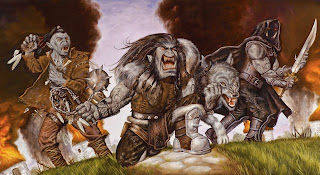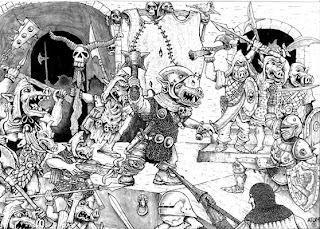ORC’S REDUX 4TH EDITION

Adventurers frequently leave the safety of civilization behind and sojourn into uncharted and uncivilized lands. The lack of civility they might encounter has no greater representative than the orc. An orc, no matter the tribe, embodies barbarism in one form or another. When you need an enemy that disrupts the civilized world by its mere presence, you need an orc or even a tribe of them. Each tribe has its own strengths, weaknesses, and goals, and the differences in each tribe can keep those dealing with them off guard. Sometimes, though, a single tribe of orcs is insufficient to achieve an end that an orc leader desires. In these cases, orc tribes join together to form a horde, and strong leaders can utilize the strengths of each tribe to lessen the weaknesses, thereby creating a stronger force.
Within a tribe, an orc’s position is determined by its strength, though strength can be a relative term depending on what the orc tribe prizes most in its members. Orcs take challenges from powerful opponents, including fellow orcs, seriously. But, true to their cunning nature, if an enemy appears close to equal or even stronger, orcs try to swarm that enemy, relying on superior numbers. Another way to exhibit the chaotic and savage tendencies of these creatures is for the orcs to change tactics and targets frequently. Orcs do not necessarily ignore the consequences of their actions, but they are extremely reactive in their offensive and defensive styles. Because of this reactive nature, orcs are just as likely to ignore a marking effect as they are to react to it. If an orc from a tribe that prefers melee strikes is marked by the party’s fighter, but the party’s rogue is responsible for a larger amount of the damage dealt to the orc, that orc is likely to ignore the penalty it takes for attacking and strike at the bothersome rogue. Let it. Nothing grabs the attention of players like a monster acting in an unexpected manner.
As creatures of conflict, orcs frequently have little patience for planning out battles. An orc’s warrior's surge power best expresses the inherent lust for battle that each orc has, and it offers Dungeon Masters a tool to add drama to a battle against orcs. An orc that uses warrior’s surge just after it becomes bloodied can surprise an enemy, but it might not have the same daunting effect as it would if used later in battle. An orc that uses the power late in the fight while on the verge of defeat forces opponents to return flagging attention to the creature. For the most drama, though, let several orcs become bloodied. Then have them all delay until they can act together, or have them react to a battle cry from their leader. The combination of several orcs using warrior’s surge and regaining a quarter of their hit points could daunt the PCs, but it also forces them to focus on a battle they might otherwise considered typical.
Perhaps a campaign doesn’t need orcs that are stalwart, though. Instead, it might call for ruthless killers that become enraged and vicious while bloodied. Substituting another power for the orc’s warrior’s surge power can help give each orc tribe a unique flavor. Some orcs might be resilient warriors, while others might be mad berserkers. To create dynamic flavor for monstrous races in a personal campaign setting, swap in new memorable powers for each of the race’s demographics. For orcs, try one of the powers below in place of warrior’s surge.
1. Warrior’s Rage (standard, usable only while bloodied; encounter) ✦ Weapon
The orc makes two melee basic attacks, each against a different target.
2. Bloodied Strike (immediate reaction, when first bloodied; encounter) ✦ Weapon
The orc makes a melee basic attack against an adjacent enemy.
3. Gruumsh’s Fervor (standard, usable only while bloodied; encounter) ✦ Weapon
While bloodied, the orc gains a +4 bonus to damage rolls.
READ Dragon 374 for the rest of the article.



Comments
Post a Comment